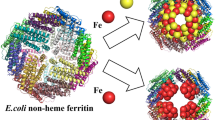Summary
Iron uptake and micelle formation in ferritin and apoferritin have been followed both spectrophotometrically and by means of sedimentation velocity experiments. Information was thus obtained on the molecular weight distribution of the reconstitution product.
To achieve incorporation ‘native’ ferritin (whole ferritin as purified from horse spleen), ‘native’ apoferritin (apoferritin prepared by fractionation of ferritin preparations) and ‘reduced’ apoferritin (apoferritin prepared by reduction of ferritin by dithionite or ascorbic acid) have been incubated with ferrous salts in the presence of oxidizing agents under different experimental conditions.
Although some iron is incorporated in ‘native’ ferritin, full saturation is not achieved and the molecular weight distribution of the incubated products remains heterogeneous.
‘Native’ and ‘reduced’ apoferritin show a similar iron incorporation, but the reconstitution products markedly differ in terms of their iron distribution.
Ferritin reconstituted from ‘native’ apoferritin has a broad molecular weight distribution, while that reconstituted from ‘reduced’ apoferritin is characterized by a narrow, homogeneous molecular weight distribution. However treatment of apoferritin with reducing or oxidizing agents prior to the incubation alters the characteristics of the iron distribution without changing the iron incorporation properties.
These results point to a role of the protein moiety not only in iron oxidation, but also in micelle formation.
Similar content being viewed by others
References
Bielig, H. S. and Bayer, E., 1955. Naturwissenschaften, 42, 125–126.
Niederer, W., 1970. Experientia, 26, 218–220.
Macara, I. G., Hoy, T. G. and Harrison, P. M., 1972. Biochem. J., 126, 151–162.
Crichton, R. R., 1969. Biochem. Biophys. Acta, 194, 34–42.
Elias, H. G., 1961. Ultrazentrifugen Methoden Beckman Instruments GmbH München.
Poulik, M. D., 1957. Nature, 180, 1477–1479.
Folin, O. and Ciocalteu, V., 1927. J. Biol. Chem., 73, 627–650.
Lowry, O. H., Rosebrough, N. J., Farr, A. L. and Randall, R. J., 1951. J. Biol. Chem. 193, 265–275.
Bryce, C. F. A., and Crichton, R. R., 1973. Biochem. J., 133, 301–309.
Stefanini, S., Chiancone, E., Vecchini, P. and Antonini, E., 1975. In Proteins of Iron Storage and Transport in Biochemistry and Medicine. Ed. R. R. Crichton, North-Holland Publishing Company, Amsterdam
Harrison, P. M. and Hoy, T. G., 1973a. In ‘Inorganic Biochemistry’ Chapter 8, p. 253–279 (Ed. G. L. Eichhorn) Elsevier, New York and London.
Author information
Authors and Affiliations
Rights and permissions
About this article
Cite this article
Stefanini, S., Chiancone, E., Vecchini, P. et al. Studies on iron uptake and micelle formation in ferritin and apoferritin. Mol Cell Biochem 13, 55–61 (1976). https://doi.org/10.1007/BF01732396
Received:
Issue Date:
DOI: https://doi.org/10.1007/BF01732396




